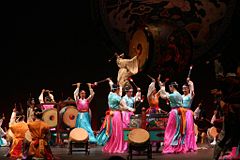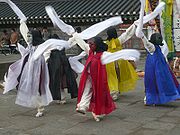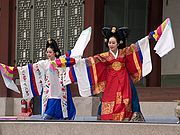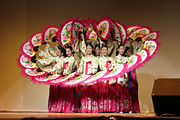
Korean dance
Encyclopedia

Korean shamanism
Korean shamanism, today known as Muism or sometimes Sinism , encompasses a variety of indigenous religious beliefs and practices of the Korean people and the Korean area...
five thousand years ago and now ranges from folk dance to newly created and adapted contemporary dance
Dance
Dance is an art form that generally refers to movement of the body, usually rhythmic and to music, used as a form of expression, social interaction or presented in a spiritual or performance setting....
.
Overview

Korean shamanism
Korean shamanism, today known as Muism or sometimes Sinism , encompasses a variety of indigenous religious beliefs and practices of the Korean people and the Korean area...
thousands of years ago. By the time of the later Korean kingdoms, Goryeo
Goryeo
The Goryeo Dynasty or Koryŏ was a Korean dynasty established in 918 by Emperor Taejo. Korea gets its name from this kingdom which came to be pronounced Korea. It united the Later Three Kingdoms in 936 and ruled most of the Korean peninsula until it was removed by the Joseon dynasty in 1392...
and Joseon
Joseon Dynasty
Joseon , was a Korean state founded by Taejo Yi Seong-gye that lasted for approximately five centuries. It was founded in the aftermath of the overthrow of the Goryeo at what is today the city of Kaesong. Early on, Korea was retitled and the capital was relocated to modern-day Seoul...
, in the 2nd millennium
2nd millennium
File:2nd millennium montage.png|From left, clockwise: In 1492, Christopher Columbus; The American Revolution; The French Revolution; The Atomic Bomb from World War II; An alternate source of light, the Light Bulb; For the first time, a human being sets foot on the moon in 1969 during the Apollo 11...
CE, Korean traditional dance benefited from regular support of the royal court, numerous academies, and even an official ministry of the government.
A number of different dances gained permanent high status, including the Hermit dance, the Ghost dance, Buchae Chum (the fan dance), Seung Mu (the Monk dance), the Oudong (Entertainer) dance and others, despite the fact that many had humble origins. For example, the Fan dance is believed to have originated with shamans performing nature rites with leaves but evolved into one of the most highly refined Korean dances.

Due to the cultural suppression
Cultural suppression
Cultural suppression occurs when a culture is suppressed, usually coinciding with the promotion of another culture. It is often related to cultural imperialism....
by Imperial Japan, so called "cultural genocide" during the Colonial Korea
Korea under Japanese rule
Korea was under Japanese rule as part of Japan's 35-year imperialist expansion . Japanese rule ended in 1945 shortly after the Japanese defeat in World War II....
, most of the dance academies died out and some dances were lost as well as some of dance forms were distorted. However, few pioneering Korean dancers such as Choi Seung-hee (최승희 崔承喜) created new forms of Korean dances based on the traditional dances and kept many of the traditions alive in secret and abroad, and today Korean traditional dance is enjoying a vibrant resurgence. Numerous universities in Korea teach Korean traditional dance, and even some universities abroad now provide instruction in the forms. Top dancers are recognized as "Living National Treasures" and are charged to pass their dances down to their students. The lineages of dance and dancers may be traced back several generations through such connections.
Types

Hanbok
Hanbok or Chosŏn-ot is the traditional Korean dress. It is often characterized by vibrant colors and simple lines without pockets. Although the term literally means "Korean clothing", hanbok today often refers specifically to hanbok of Joseon Dynasty and is worn as semi-formal or formal wear...
. Emotional attributes of the dances include both somberness and joy. The dancer must embody the fluid motion that surges through the traditional music that the dancers perform to. Korean traditional dance is often performed to Korean traditional music, which includes traditional drums, flutes, and more. The music is what upholds the dance and the dancer is the tool that shows the music in physical form.
Court dance
Korean court dances is called "jeongjae" (hangulHangul
Hangul,Pronounced or ; Korean: 한글 Hangeul/Han'gŭl or 조선글 Chosŏn'gŭl/Joseongeul the Korean alphabet, is the native alphabet of the Korean language. It is a separate script from Hanja, the logographic Chinese characters which are also sometimes used to write Korean...
:정재, hanja
Hanja
Hanja is the Korean name for the Chinese characters hanzi. More specifically, it refers to those Chinese characters borrowed from Chinese and incorporated into the Korean language with Korean pronunciation...
:呈才) which originally referred to "display of all talent" including not only dance but also other performing arts such as jultagi
Jultagi
Jultagi or eoreum is traditional Korean performance of tightrope-walking. It is included into South Korea's Important Intangible Cultural Properties number 58.-Origin:...
(줄타기 tightrope walking), gong deonjigi (공던지기), and mokmatagi (목마타기) but gradually only denoted "court dance". The term has been used since the early period of Joseon dynasty
Joseon Dynasty
Joseon , was a Korean state founded by Taejo Yi Seong-gye that lasted for approximately five centuries. It was founded in the aftermath of the overthrow of the Goryeo at what is today the city of Kaesong. Early on, Korea was retitled and the capital was relocated to modern-day Seoul...
.
Jeongjae were used to perform for the royal family, court officials, and foreign envoys or for festive occasions sponsored by the state. Jeongjae is divided into the two categories, "Dangak jeongjae" (당악정재) and "Hyangak jeongjae" (향악정재). Dangak jeongjae are dances derived from court dances of Tang China during the Goryeo dynasty, whereas the other consist of newer court dances originated in Korea.
Hyangak jeongjae


- Ahbakmu (아박무), Ivory clappers dance
- Bakjeopmu (박접무), fluttering butterfly wings dance
- Bonglaeui (봉래의), phoenix dance
- CheoyongmuCheoyongmuCheoyongmu is a representative Korean mask dance based on the legend of Cheoyeong , a son of the Dragon King of the Eastern Sea. It is also the oldest surviving Korean court dance created during the Unified Silla period...
(처용무), dance of Cheoyong, Dragon King's son which is the oldest jeongjae originaed in the Silla period - Chunaengjeon (춘앵전) dance of the spring nightingaler
- GainjeonmokdanGainjeonmokdanGainjeonmokdan is a Korean court dance ,and literally means "beautiful people plucking peonies". This jeongjae was initiated and arranged by Hyomyeong Seja in 1829 to please his father, King Sunjo...
(가인전목단), dance depicting beautiful women picking peonies - GeommuGeommuGeommu is a traditional sword dance practiced in Korea. Geommu is performed with special costume, dance motions, and music. The dance is known for its grace in performance. Extra emphasis is placed on the movement of the costuming, notably the sleeves, in harmony with the movements of the dancer...
(검무), sword dance- Jinju geomu
- Hakyeon hwadaemu (학연화대무), Crane and lotus pedestal dance
- Goguryeomu (고구려무), Goguryeo dance
- Muaemu (무애무)
- Musanhyang (무산향), fragrance of dancing mountain dance
- MugoMugoMugo is a jeongjae, Korean court dance performed with drum. It was created in the Goryeo dynasty era. It also practiced in ritual dance of Seungjeonmu...
(무고), drum dance- Gyobang mugo (교방무고)
- Sajamu (사자무), lion dance
- Seonyurak (선유락), boating party dance
Dangak jeongjae
- Monggeumcheok (몽금척), dream of golden ruler dance
- Pogurak (포구락) ball game dance
- Heonseondo (헌선도), peach-offering dance
Folk dance


- Byung shin chumByung shin chumByung shin chum is a Korean folk dance that was performed by the lower class peasants to satirize the Korean nobility by depicting them as the handicapped persons and sick persons such as paraplegics, midgets, hunchbacks, the deaf, the blind, lepers, as well as characters from Pansori and other...
(병신춤), dance mocking handicapped and mentally disabled people - SeungmuSeungmuSeungmu is a Korean dance performed by Buddhist monks. It is one of the most famous Korean traditional dances and designated as South Korea's important intangible cultural asset number 27 in 1969. It has been developed into a solo dance by professional dancers nowadays.-Origins:There is little...
(승무), monk dance - SeungjeonmuSeungjeonmuSeungjeonmu is a Korean court dance to wish for and celebrate victory. It is originated 2000 years ago and is composed of a sword dance and drum dance called mugo. Seungjeonmu or Dance of Military Triumph was performed to wish for victory from gods of earth and heaven when the nation was at war...
(승전무), literally victory dance - Salpuri (살풀이), literally spirit-cleansing dance
- Hallyangmu (한량무), dance of prodigal man in yangbanYangbanThe yangban were part of the traditional ruling class or nobles of dynastic Korea during the Joseon Dynasty. The yangban were either landed or unlanded aristocracy who comprised the Korean Confucian idea of a "scholarly official." In reality, they were basically administrators and bureaucrats who...
class - Ipchum (입춤), also called "ipmu" or "gibonchum", literally basic dance
- TaepyeongmuTaepyeongmuTaepyeongmu is a Korean dance with the function of wishing a great peace for the country. Its exact origin is unknown, but Hahn Seongjun , a well known dancer and drummer, rearranged the dance in the early 20th century. There are three assumptions regarding the origin of Taepyeongmu...
(태평무), dance to wish great peace - Ganggang sullae (강강술래), maidens' circle dance
- Nongak (농악), farmers' performance
- TalchumTalchumTalchum could be characterized as a Korean dance performed while wearing a mask, miming, speaking and even sometimes singing. Although most Koreans believe that talchum refers to all mask dance dramas, it is in fact a regional term only properly applied to dances of Hwanghae Province in present day...
(탈춤), mask dance - Miyalhalmi chum (미얄할미춤), old woman's dance
- Palmeokjung chum (팔먹중), dance of the eight unworthy monks
- Dongrae hakchum (동래학춤), crane dance performed in Dongrae, BusanBusanBusan , formerly spelled Pusan is South Korea's second largest metropolis after Seoul, with a population of around 3.6 million. The Metropolitan area population is 4,399,515 as of 2010. It is the largest port city in South Korea and the fifth largest port in the world...
- Buponorichum (부포놀리춤), feather tassel dance
- Chaesang sogochum (채상 소고춤), tambour Dance
- Deotbaegichum (덧배기춤), thrust dance
- Gaksichum (각시춤), maiden's dance
Ritual dance
Ritual dance in Korea designates a Buddhist dance and Korean folk dances.- Ilmu (일무), literally line Dance
- Jakbeop (작법)
- Beopgochum (법고춤), Dharma drum dance
- NabichumNabichumNabichum is a Korean Buddhist dance for ritual service. The dance is named after its choreography and costume which resemble the appearance of butterfly . Some people regard nabichum as the most representative and important dance among Korean Buddhist dances...
(나비춤), literally butterfly dance - BarachumBarachumBarachum is a representative of the Korean Buddhist ritual dance, , and is performed by Buddhist monks with bara . The term bara describes a cymbal-like Korean instrument made with brass. The dance is composed of splendid and complicated movements among the jakbeop. Performers playing bara...
(바라춤), bara dance (바라, cymbals)
- Musokchum, or mumu (무속춤, or 무무), dance by mudang (무당, shamanKorean shamanismKorean shamanism, today known as Muism or sometimes Sinism , encompasses a variety of indigenous religious beliefs and practices of the Korean people and the Korean area...
)

New traditional dance
- Buchaechum (부채춤), fan dance created by Kim Baek-bong (김백봉 金白峰) and first presented in public in 1954
- Hwagwanmu (화관무), floral coronet dance
- Jangguchum (장구춤), dance with jangguJangguThe janggu or sometimes called seyogo is the most widely used drum used in the traditional music of Korea. It is available in most kinds, and consists of an hourglass-shaped body with two heads made from animal skin...
, hourglass-shaped drum - Samgomu Ogomu (삼고무 오고무), a drum dance
- Grand Drum Ensemble (북의 대합주), a drum dance composed by Guk Su-ho (국수호) in 1981. The instruments comprise of all Korean drums.
See also
- Korean artKorean artKorean art is art originating or practiced in Korea or by Korean artists, from ancient times to today. Korea is noted for its artistic traditions in pottery, music, calligraphy, and other genres, often marked by the use of bold color, natural forms, and surface decoration.-Introduction:The earliest...
- Korean musicKorean musicTraditional Korean music includes both the folk, vocal, religious and ritual music styles of the Korean people. Korean music, along with arts, painting, and sculpture has been practiced since prehistoric times....
- Korean culture
- Important Intangible Cultural Properties of Korea
- Korean ShamanismKorean shamanismKorean shamanism, today known as Muism or sometimes Sinism , encompasses a variety of indigenous religious beliefs and practices of the Korean people and the Korean area...
- Korean BuddhismKorean BuddhismKorean Buddhism is distinguished from other forms of Buddhism by its attempt to resolve what it sees as inconsistencies in Mahayana Buddhism. Early Korean monks believed that the traditions they received from foreign countries were internally inconsistent. To address this, they developed a new...
- Korean ConfucianismKorean ConfucianismKorean Confucianism is the form of Confucianism developed in Korea. One of the most substantial influences in Korean intellectual history was the introduction of Confucian thought as part of the cultural influence from China...
- List of Korea-related topics

